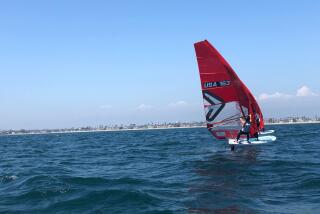The Shape of Speed
- Share via
Many factors affect the speed of a sailboat. The International America’s Cup Class is a development class, encouraging advanced technology, but innovation is limited by the class rules, forcing designers to balance sail area, displacement and waterline length. Add one and you must subtract another. The wealthier syndicates have experimented with various sail shapes and hull and keel configurations for the past two or three years to arrive at the boats they committed to the Cup.
NEW CLASS, NEW FORMULA
A new International America’s Cup Class is being raced for the first time in the 28th America’s Cup Races. The International America’s Cup Class Rule is a complicated formula combining primarily length-displacement sail area, but with many limitations and penalties on other dimensions.
ENGINE OF WIND
A sail acts much like the wing of an airplane. As air flows over the two surfaces of the sail, lift develops, just like the lift on an airplane’s wing. This lift pulls the sail forward and with it the boat. As wind blows over the sails, the flow becomes attached to the leeward side of the sail, creating a vacuum and pulling the sail toward the airflow. This force is lift, and it acts at right angles to the sail at every point. Most of the force is generated near the leading edge of the sail, which is more in the direction the boat should go.
ANATOMY OF A SAIL
There are four types of basic sails used on the IACC boats: mains, spinnakers and gennakers. Occasionally, on a reaching leg (across the wind), a boat also will fly a staysail, a smaller sail set between the mast and a gennaker. Mainsails and genoa headsails usually are made of Kevlar, the same plastic-like material used in bullet-proof vests, although the America 3 and II Moro di Venezia teams have used newly developed mains made of carbon-fiber, and America 3 also has used liquid crystal material. Spinnakers usually are made of lightweight nylon. Gennakers may be nylon or a heavier material.
TYPES OF SAILS
Jib and Genoa: The jib is a triangular sail set forward of the mast and a Genoa is an overlapping foresail providing more sail area.
Mainsail: The rear (aft) sail that reaches the top of the mast and is never changed during a race. Upwind it is trimmed just tight enough inboard to prevent it from luffing (flapping loosely). Off the wind it is set square to the following wind.
Gennaker: A triangular, billowing headsail, asymmetrical in shape, usually set for offwind reaching legs (across the wind). In very light wind, they will also be used for downwind legs because the boats must sail at sharp angles to make progress toward the mark.
Spinnaker: A larger, symmetrical parachute-like headsail used only on downwind legs. At 4,500 square feet, it would cover a basketball court.
WATER WINGS
A keel serves two purposes. It provides weight (ballast) to keep the boat from tipping over, and it provides resistance to leeway, or sliding sideways when sailing upwind. A well-designed keel also will provide lift, helping the boat to sail more toward the wind. A critical part of the new technology of IACC boats is the keel. Several syndicates have experimented with tandem keels, seeking improved hydrodynamics. Most, including Dennis Conner’s Stars & Stripes, failed. New Zealand had the only boat to make it to the challenger or defender finals with a tandem keel, Keels are the tightest secrets around the America’s Cup.
More to Read
Sign up for The Wild
We’ll help you find the best places to hike, bike and run, as well as the perfect silent spots for meditation and yoga.
You may occasionally receive promotional content from the Los Angeles Times.






